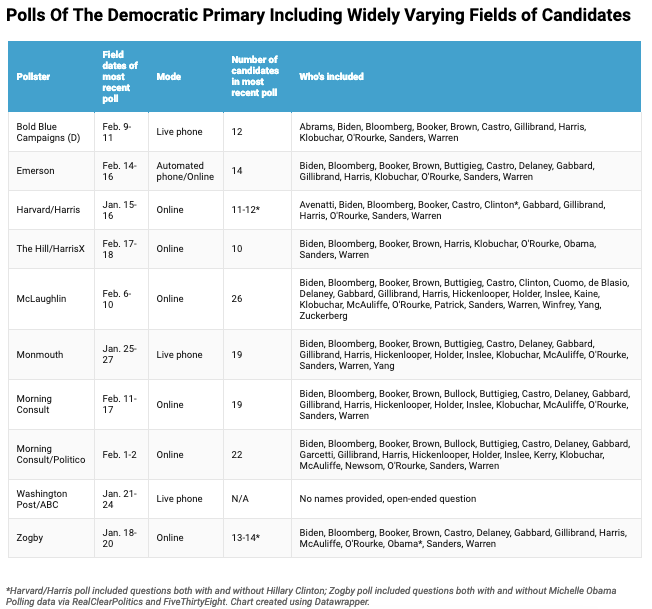
Next year’s Democratic primary may already have its first putative front-runner. Most early polls of the Democratic presidential primary show former Vice President Joe Biden ― who’s yet to declare a run ― at the top of the pack nationally, although nowhere near the majority support Hillary Clinton had amassed by this point in 2015.
But it’s important to be careful about overinterpreting early horserace polls of the 2020 Democratic primary. One big reason is that it’s tough to poll a race when nobody’s yet quite sure who’s running in it.
Only a relatively small numbers of pollsters have even started to ask Democrats directly about their voting preferences, rather than looking at broader concerns about the election or opinions of possible candidates. But those who have face a challenge. The potential Democratic field is still so gigantic that it exceeds the number of buttons available on a touch-tone phone, and so fluid that one polling firm found itself pulling a candidate from their survey an hour before interviewers started their calls.
The choice of names included in a survey can have profound effects on the results. This early in the 2020 primaries, some critics have argued, presenting a laundry list of candidates can drive voters without strong preferences to latch onto known quantities like Biden. But attempts to winnow the field can backfire too: In California’s similarly wide senatorial race last year, one effort to pare down the candidates ended up driving a fictitious spike in support for a neo-Nazi.
Starting next year, surveys of the upcoming election will also help decide who gets a televised platform for their campaign. The Democratic National Committee announced last week that it would determine candidates’ inclusion in next year’s debates in part by their standing in the polls.
That presents a certain irony, given that, as the chart below shows, there’s not yet a consensus among pollsters on who merits inclusion in those surveys themselves.

Publicly-released national horserace polls this year have included anywhere from as few as seven candidates to as many as 26, as well as a Washington Post/ABC News survey that eschewed the format entirely and simply asked Democrats to name the person they’re supporting. That variation makes it hard to draw meaningful comparisons between surveys from different outlets, or even between past and present surveys from the same pollsters.
Thirty-five different people have shown up as potential candidates in at least one of those polls. There’s a group of high-profile politicians who’ve already thrown their hats into the ring, and are near-universally included. Sen. Elizabeth Warren (D-Mass.), Sen. Kamala Harris (D-Calif.) and Sen. Kirsten Gillibrand (D-N.Y.), for instance, show up in every survey with named candidates.
But with other groups, there’s less consistency. Longshot declared candidates like entrepreneur Andrew Yang and former Maryland Rep. John Delaney show up in a few surveys, but not others. Some politicians who were included in polls as recently as January have since dropped out (former West Virginia state Sen. Richard Ojeda), announced they’re not running (Los Angeles Mayor Eric Garcetti) or decided on making a third-party run (former Starbucks CEO Howard Schultz). Then there are people who have given no public indication that they’re considering a 2020 run but have shown up in a poll or two anyway, including Hillary Clinton, Michelle Obama and Oprah.
Pollsters’ decisions for whom to include rest on a mixture of factors, including individual discretion, past experience and the limitations of technology.
After polling 17 candidates in 2016′s GOP primary, “we figured we could handle a large field,” said Monmouth University pollster Patrick Murray. But this year, he sees close to 30 realistic possibilities for the Democratic nominee ― which is a lot of names for a poll-taker to read one by one over the phone.
For their January poll, Monmouth whittled their list down to 19, starting with office-holders who had declared their candidacy, announced an exploratory committee or filed with the Federal Election Commission. Yang, who’s not an elected official, also made the cut because he had more than $500,000. Monmouth’s poll also included “names we know already have a high profile,” and those who seemed “likeliest to get in or would have some potential advantages if they did,” including current and former state governors.
Online polls, which can present a list of possible candidates, have a little more leeway. “We’ve really taken an expansive approach when looking at the field,” said Jeff Cartwright, the vice president of content for Morning Consult, whose surveys have included up to 22 candidates. McLaughlin, whose February poll including more than two dozen candidates, was also conducted online.
By contrast, pollsters using automated phone surveys (think “If you would vote for Candidate A, press 1. For Candidate B, press 2”) face a particularly acute technical limitation: There are only 10 numbers on a telephone.
Emerson College’s polling society, which conducts their survey partly with automated phone calls and partly online, has experimented with a few ways of asking about the field since December. In some versions, they limited their slate to just six or seven “higher profile” potential candidates, or candidates who’d already announced, said Isabel Holloway, the group’s research assistant.
Another version included 14 candidates, with voters hearing the names of the first seven candidates alphabetically, along with the option to pick “someone else.” Only those who took that option heard the rest of the candidates’ names. That approach was scrapped as potentially confusing. In the next iteration, voters taking the automated phone poll instead heard the names of seven candidates in randomized order, followed by a prompt to hear “more options.” Voters taking the survey online, meanwhile, just saw the full list.
Given the variation in approaches, it’s not surprising that Emerson’s results have varied as well. Their national polls since December have found Biden polling at anywhere between 26 percent and 45 percent, Warren at a low of 7 percent and a high of 43 percent, and Sanders between 5 and 22 percent. All of that likely says more about the change in the polling than any real movement in the race.
Other pollsters are finding ways around the dilemma entirely.
“In a field this large and at this early stage,” it made sense to ask voters to name their choice without the benefit of a list, said Scott Clement, the polling director for The Washington Post. “We found that 56 percent of Democratic-leaning adults didn’t name a current preference and no candidate reached double digits, indicating how wide-open the primary contest is and that many candidates have an opportunity to establish a competitive level of support before voting begins.”
With the field still so open, other metrics like name recognition and favorability ratings may serve at least as well at sketching out the current state of the campaign.
“As with any presidential nominating contest at this point in time, voter preferences are driven largely by name recognition,” Murray said. “It would be very unusual if these results don’t change substantially when we get closer to next year’s primary contests. These early polls are most useful for looking at each candidate’s profile among the party faithful to assess potential viability.”
